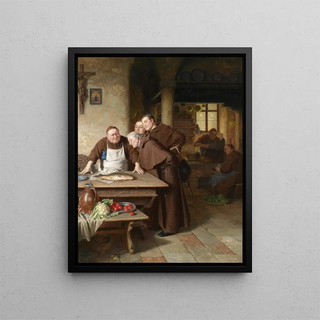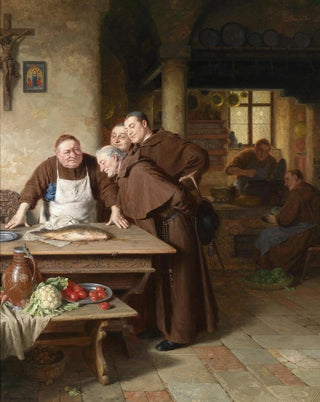Painting In the monastery kitchen - Eduard von Grützner | Art print


View from behind

Frame (optional)
In the warmth and intimacy of a monastic kitchen, the artwork "In the Monastery Kitchen" by Eduard von Grützner immerses us in a universe rich in colors and emotions. This painting, which captures a simple and authentic moment of life, evokes the serenity of daily life rhythmically driven by work and conviviality. The characters, with expressive faces, seem engaged in a common task, thus reinforcing the sense of community and sharing. Grützner, with his skill in representing light and textures, invites us to feel the warmth of this space, where the aroma of simmered dishes seems almost tangible. This artwork, through its careful composition and soothing atmosphere, becomes a true window into a bygone world, yet still fascinating.
Style and uniqueness of the artwork
Eduard von Grützner's style is characterized by vibrant realism, where every detail is carefully observed and rendered. In "In the Monastery Kitchen," the artist uses warm, earthy colors, creating an ambiance that is both welcoming and comforting. The subtly orchestrated play of light highlights the textures of the characters' clothing and the surfaces of kitchen utensils, enhancing the scene's authenticity. This painting also stands out for its ability to tell a story through gestures and expressions, demonstrating Grützner's mastery in the art of visual storytelling. The attention to detail, whether it is the ingredients arranged on the table or the monks' expressions, makes this artwork a true scene of life, where each element contributes to the overall harmony.
The artist and his influence
Eduard von Grützner, a German painter of the 19th century, is renowned for his works capturing scenes of everyday life, often imbued with subtle humor and palpable tenderness. His academic training and interest in realism led him to explore various themes, but it is in the depiction of monks and monastic life that he excels particularly. Grützner manages to transcend simple portraiture or genre scenes to offer a reflection on spiritual life.

Matte finish

View from behind

Frame (optional)
In the warmth and intimacy of a monastic kitchen, the artwork "In the Monastery Kitchen" by Eduard von Grützner immerses us in a universe rich in colors and emotions. This painting, which captures a simple and authentic moment of life, evokes the serenity of daily life rhythmically driven by work and conviviality. The characters, with expressive faces, seem engaged in a common task, thus reinforcing the sense of community and sharing. Grützner, with his skill in representing light and textures, invites us to feel the warmth of this space, where the aroma of simmered dishes seems almost tangible. This artwork, through its careful composition and soothing atmosphere, becomes a true window into a bygone world, yet still fascinating.
Style and uniqueness of the artwork
Eduard von Grützner's style is characterized by vibrant realism, where every detail is carefully observed and rendered. In "In the Monastery Kitchen," the artist uses warm, earthy colors, creating an ambiance that is both welcoming and comforting. The subtly orchestrated play of light highlights the textures of the characters' clothing and the surfaces of kitchen utensils, enhancing the scene's authenticity. This painting also stands out for its ability to tell a story through gestures and expressions, demonstrating Grützner's mastery in the art of visual storytelling. The attention to detail, whether it is the ingredients arranged on the table or the monks' expressions, makes this artwork a true scene of life, where each element contributes to the overall harmony.
The artist and his influence
Eduard von Grützner, a German painter of the 19th century, is renowned for his works capturing scenes of everyday life, often imbued with subtle humor and palpable tenderness. His academic training and interest in realism led him to explore various themes, but it is in the depiction of monks and monastic life that he excels particularly. Grützner manages to transcend simple portraiture or genre scenes to offer a reflection on spiritual life.
12,34 €






